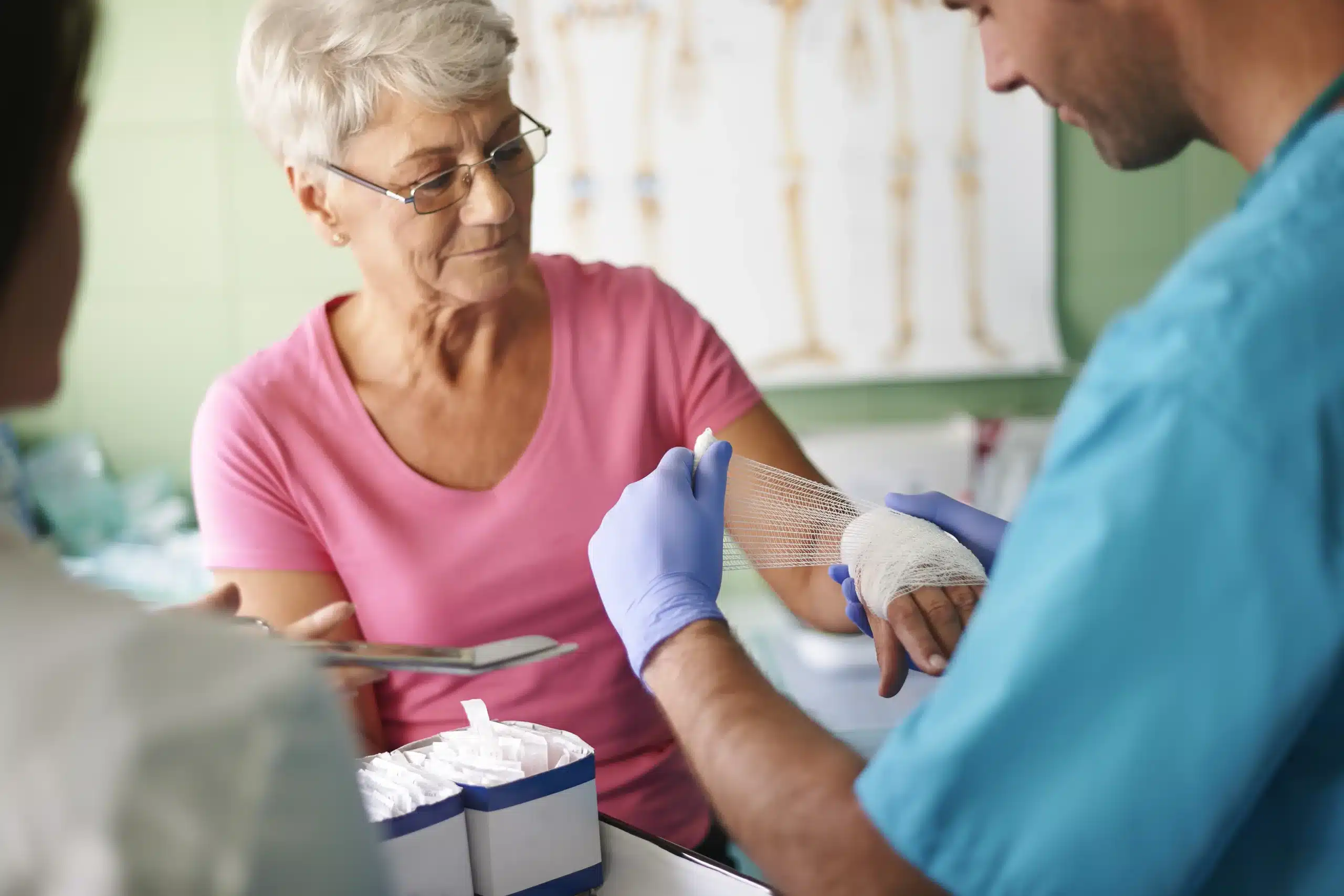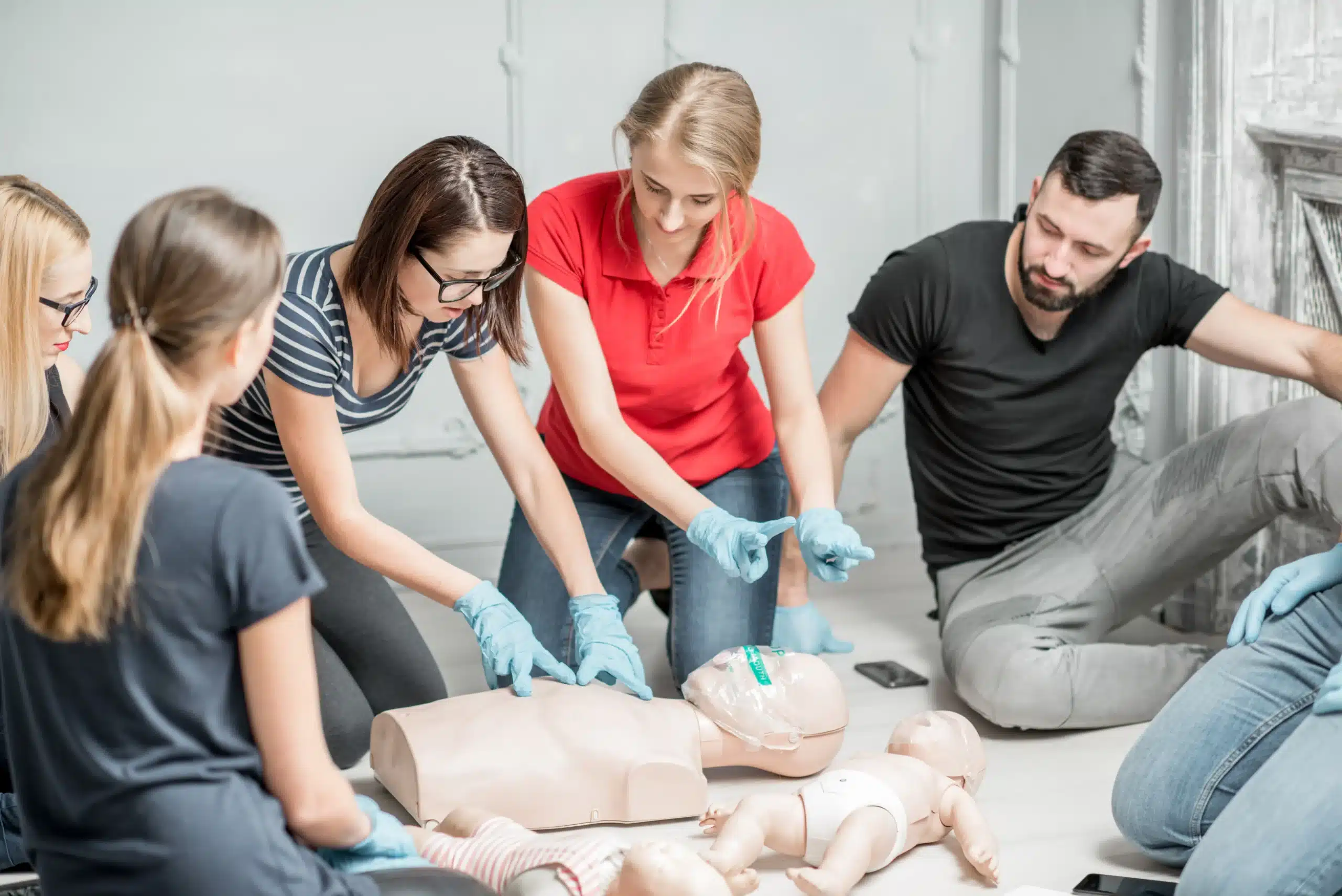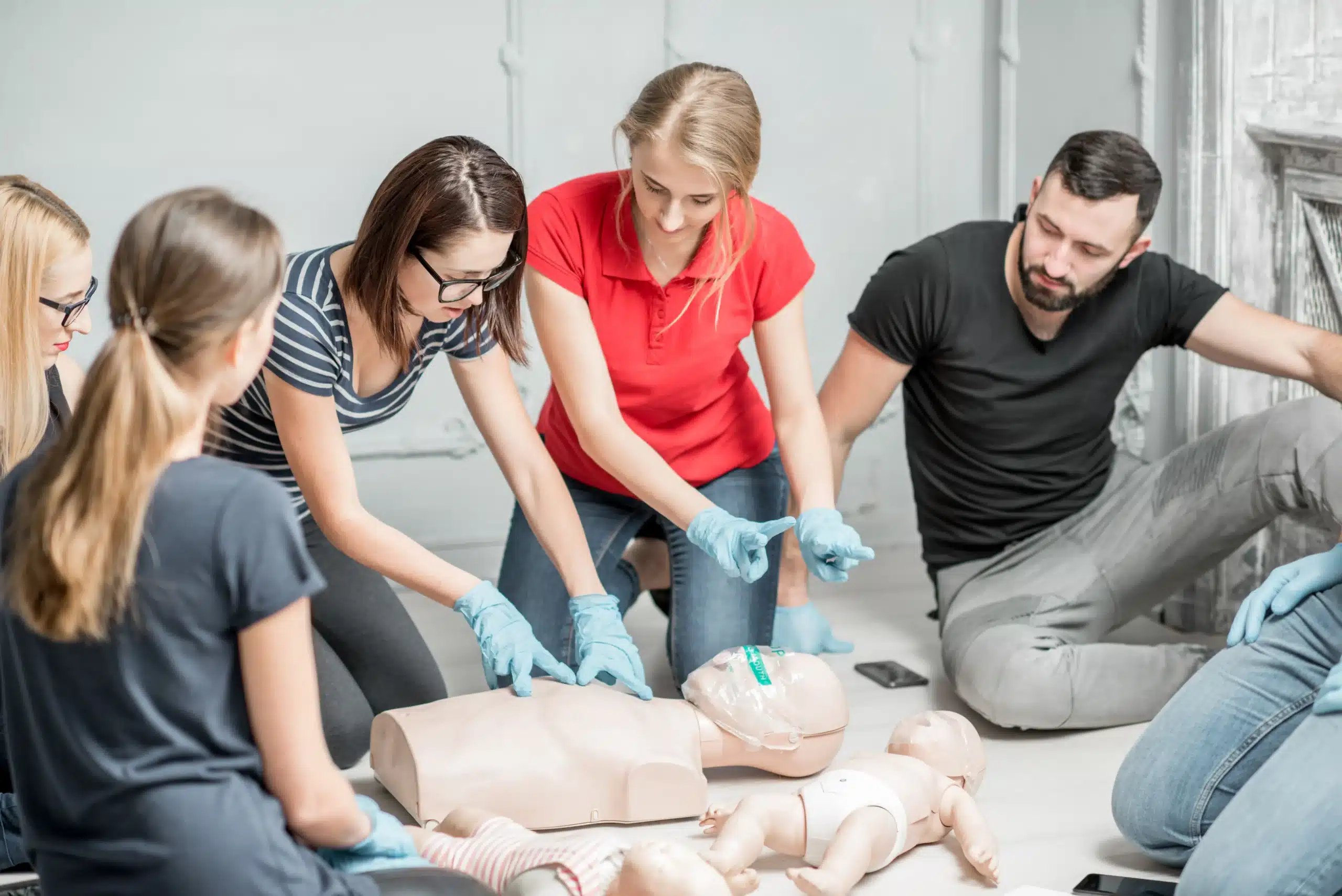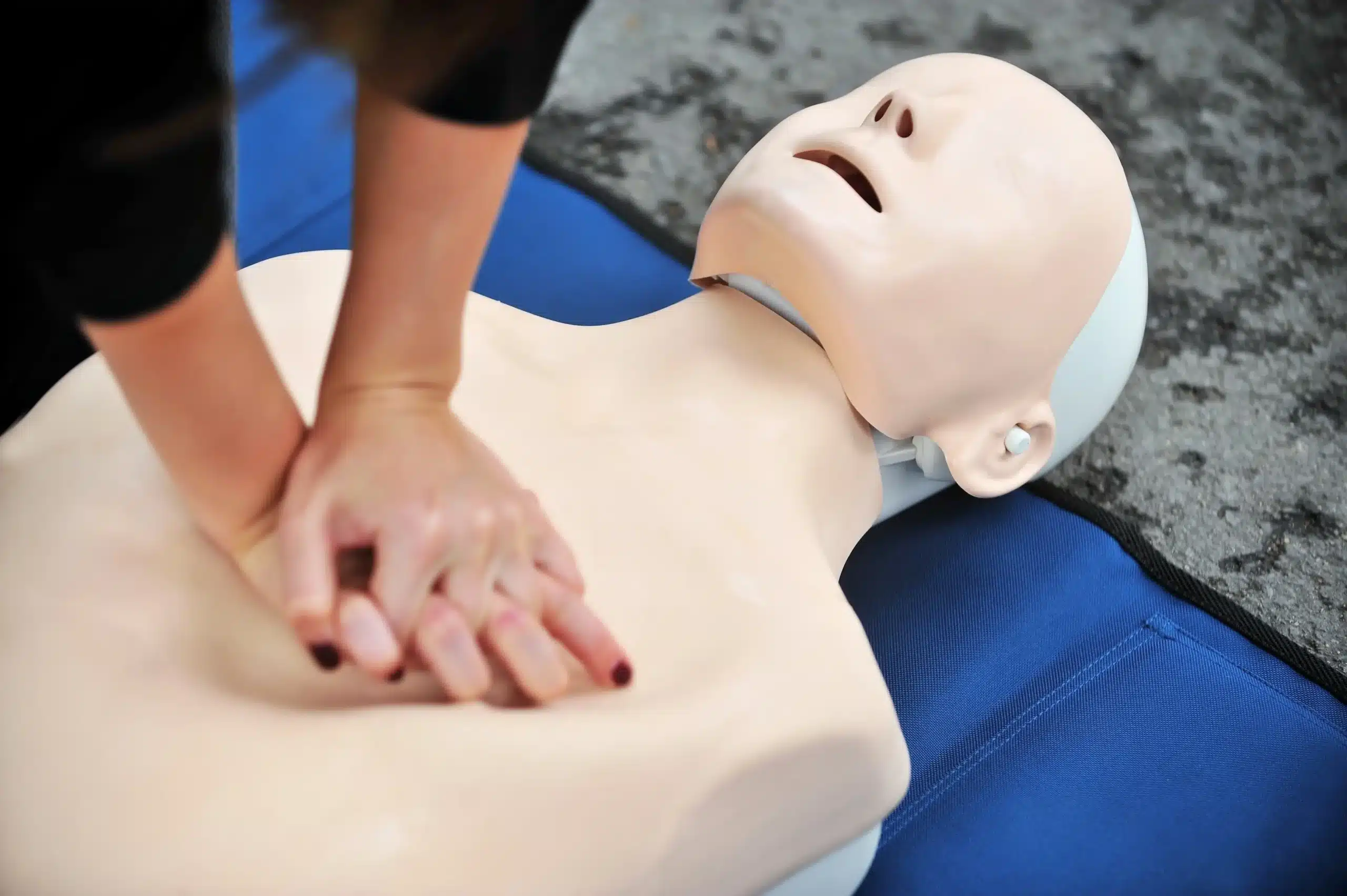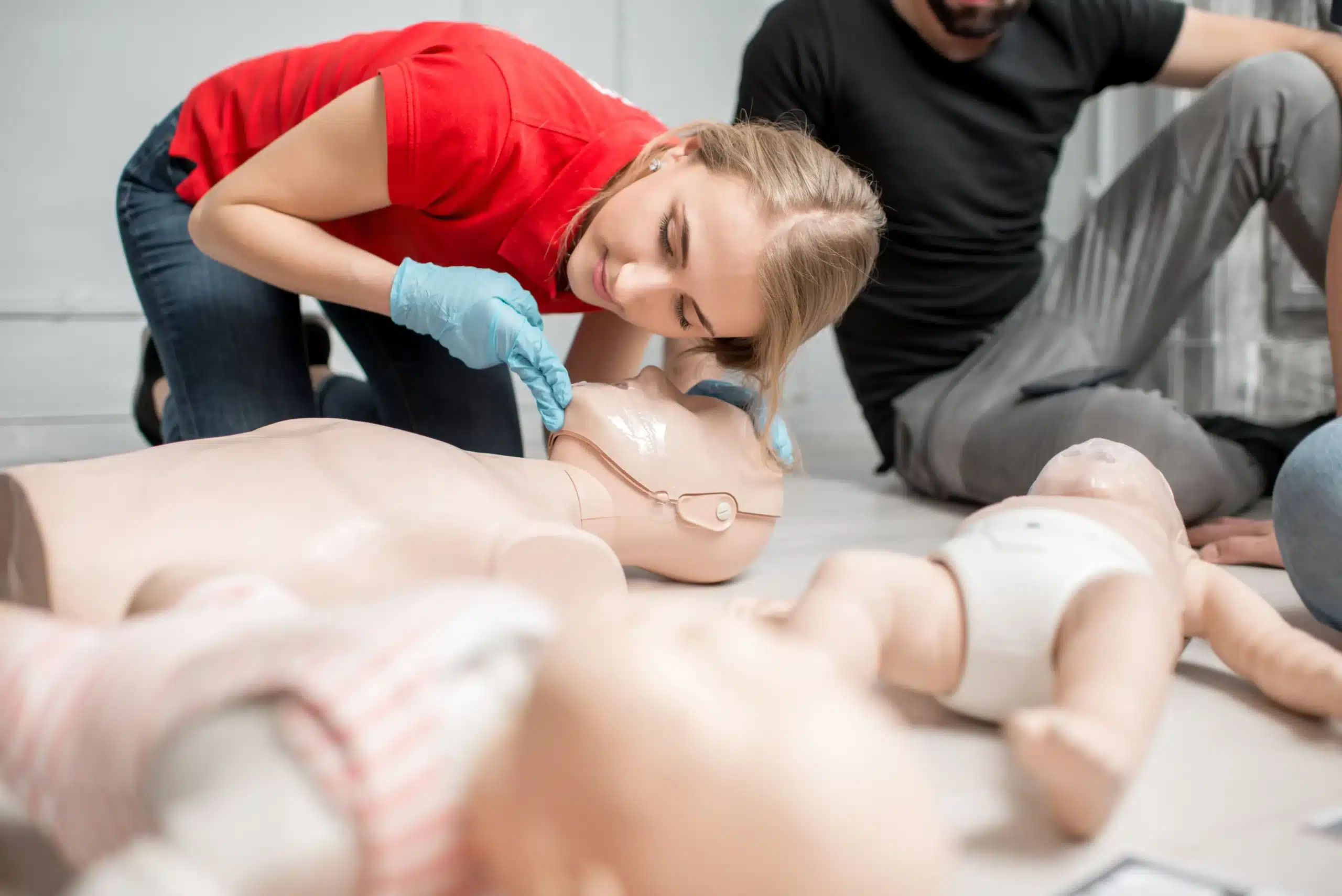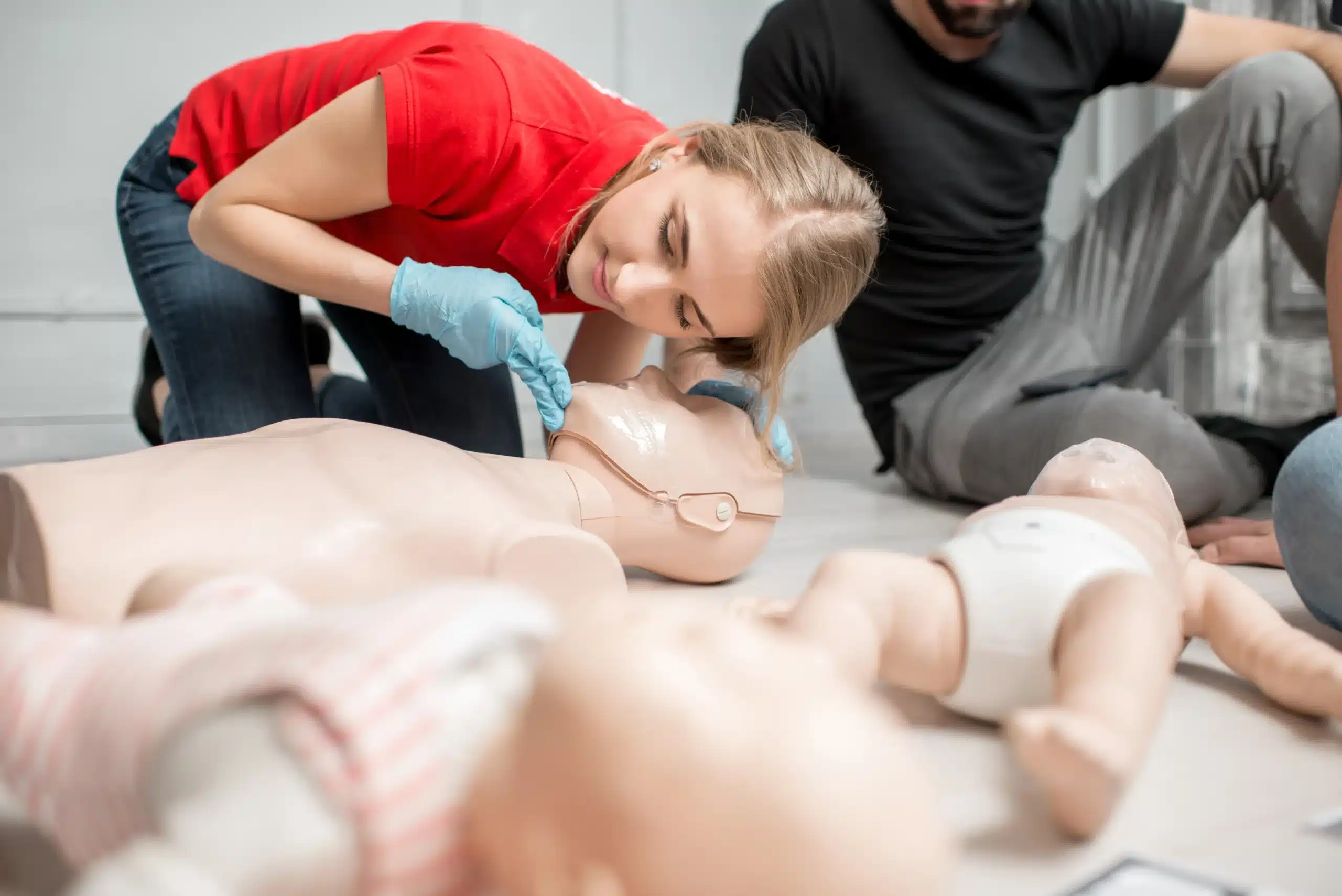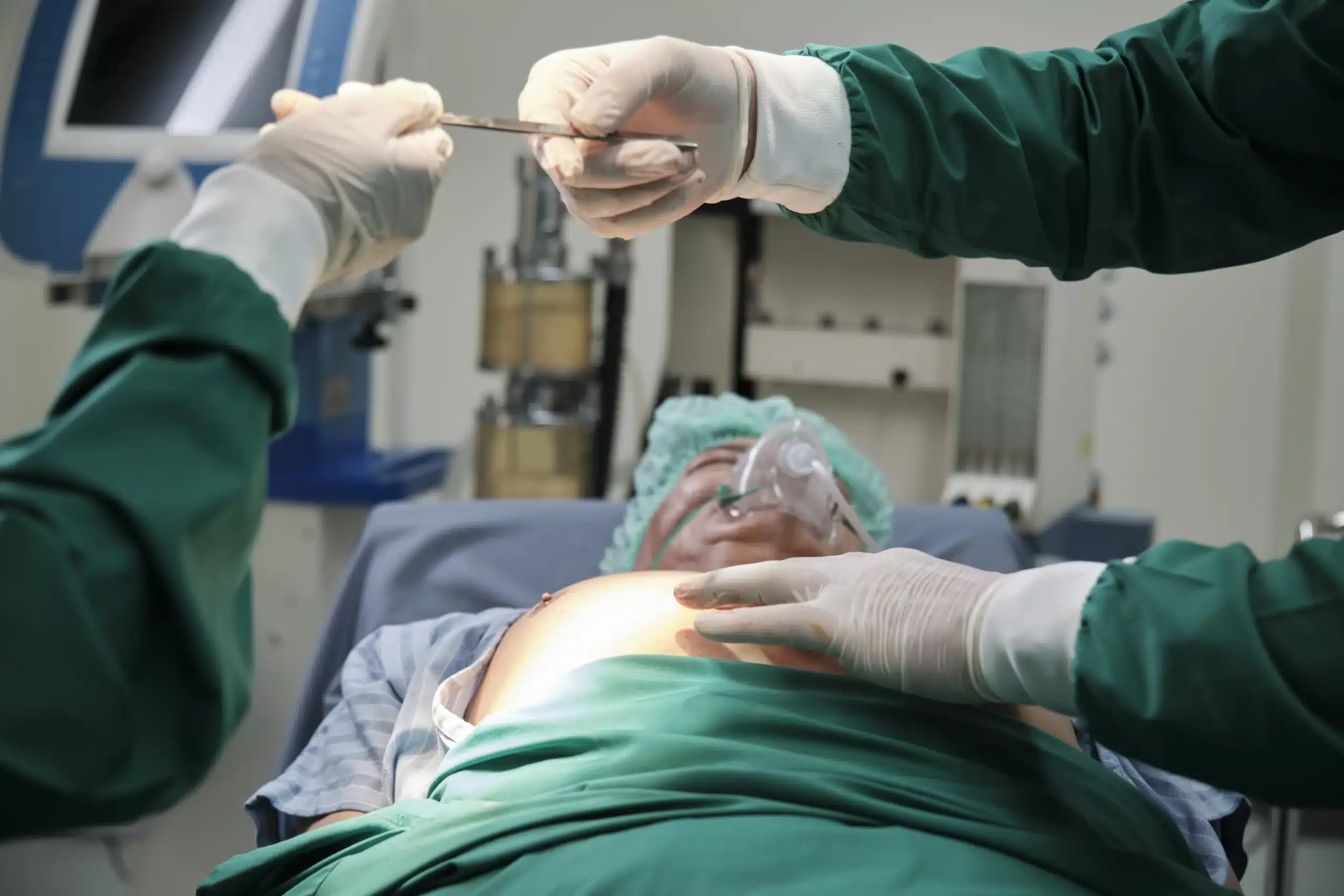CPR training is a powerful skill that can make a profound difference in a medical emergency. This guide simplifies the process of finding and choosing the right CPR training program for you. We’ll discuss the various types of CPR certification, the importance of hands-on practice, and what to expect during a typical CPR course. We’ll also explore the benefits of CPR training, both personally and professionally, and provide resources for finding CPR training in Windsor and surrounding areas. Whether you’re a parent, teacher, healthcare worker, or simply someone who wants to be prepared, this guide will help you take the first step towards becoming CPR certified.
Key Takeaways
- CPR skills empower everyone: From healthcare providers to everyday people, CPR training equips you to handle emergencies and potentially save lives. Find a course that fits your lifestyle and learn these essential skills.
- Select the right CPR training: Seek out certified instructors, hands-on practice, and certification from a recognized organization like the American Heart Association. Consider course format, schedule, and cost to find the best fit.
- Stay current with your CPR certification: Guidelines and techniques evolve. Regular recertification keeps your skills sharp and ensures you’re prepared to provide effective assistance when it matters most.
What is CPR Training?
CPR training equips you with the skills to respond to cardiac arrest and other medical emergencies. These courses teach rescue breathing and chest compressions, techniques that help maintain blood flow and oxygen to the brain until professional medical help arrives. Learning CPR can make a profound difference in someone’s life.
CPR for Everyone
CPR training isn’t just for healthcare professionals—it’s a valuable skill for everyone. From parents and teachers to babysitters and lifeguards, knowing CPR can empower you to act quickly in a crisis. Many organizations, like Windsor EMS, offer American Heart Association-certified CPR courses covering CPR techniques for adults, children, and infants, as well as training on how to use an Automated External Defibrillator (AED). These courses are perfect for anyone who wants to be prepared for an emergency, particularly in a work setting.
CPR for Healthcare Providers (BLS CPR/AED)
Healthcare providers, including doctors, nurses, and EMTs, require specialized CPR training. This training, often called BLS CPR/AED for Healthcare Providers or simply BLS for Healthcare Providers, covers advanced life support techniques tailored to the medical field. These courses provide a two-year certification upon completion and are essential for maintaining professional credentials. Safety Training Seminars offers these advanced courses, ensuring healthcare professionals in Santa Rosa, Rohnert Park, and Windsor have access to high-quality training.
CPR and First Aid Certification
Organizations like the Canadian Red Cross also offer CPR and first aid training through authorized providers like Windsor/Essex CPR. These certification courses meet workplace, school, and personal needs, aligning with various standards, including WSIB, Federal, and Provincial requirements. This makes them a versatile option for individuals and businesses alike. Combining CPR and first aid training provides comprehensive preparedness for a range of emergencies.
Workplace First Aid
Many workplaces require employees to have first aid training. This is often a legal requirement, ensuring businesses have personnel prepared to handle medical emergencies on-site. On-site training options are available through providers like Windsor/Essex CPR, making it convenient for employers to meet these obligations and keep their teams safe. Investing in workplace first aid training demonstrates a commitment to employee safety and can create a more secure work environment.
CPR Training Costs
CPR training is an investment in your skills and the well-being of your community. Understanding associated costs can help you budget accordingly. While pricing varies depending on the provider and the specific course, this section offers a general overview of what you can expect. Remember to check with individual providers like Safety Training Seminars for their most up-to-date pricing.
Typical Course Fees
Several factors influence CPR course fees. The type of certification you pursue—whether it’s basic CPR and first aid or advanced certifications like ACLS—will impact the cost. Course length also plays a role, with longer, more comprehensive courses typically costing more. Location can also affect pricing, as costs can differ between training centers and regions. Finally, the training provider sets their own pricing, so comparing options is wise. Contact various providers in your area, such as those listed later in this post, to inquire about specific course fees. Safety Training Seminars offers a low price guarantee, ensuring competitive pricing for their courses.
Group Discounts
Many CPR training providers offer discounts for group registrations. This can be a great option for workplaces, community groups, or families who want to train together. Group discounts reduce the individual cost and allow for a shared learning experience. Check with your chosen provider about their requirements for group discounts. Some providers may have minimum group sizes or specific scheduling requirements.
Invest in Life-Saving Skills
Think of CPR training as an investment, not an expense. Learning these skills empowers you to respond effectively in emergencies and potentially save a life. While there’s a financial cost associated with the training, the value of your new skills is immeasurable. Consider the peace of mind that comes with knowing you’re prepared to handle a critical situation. This preparedness extends beyond personal benefit, equipping you to assist family, friends, coworkers, and even strangers. When you choose CPR training, you’re investing in a safer community. Consider also exploring options like RQI classes for specialized resuscitation training.
How Long Does CPR Certification Last?
Knowing the duration of your CPR certification is crucial for maintaining your skills and credentials. This section covers everything you need to know about CPR certification validity, why recertification matters, and how to renew your certification.
Certification Validity
CPR and First Aid certifications are generally valid for two years. This standard applies to most providers, ensuring that individuals regularly refresh their knowledge and skills. Keeping your certification current is essential for providing effective assistance in emergencies. For specific certification details, check with your certifying organization or a local training provider like Safety Training Seminars.
Why Recertify?
CPR techniques and guidelines can change as new research emerges and best practices evolve. Recertification ensures you stay up-to-date with the latest life-saving procedures. It reinforces your skills and knowledge, giving you the confidence to respond effectively in critical situations. Regularly updating your certification demonstrates your commitment to providing high-quality care and maintaining your competence in CPR. Explore resources like the American Red Cross for more information on the importance of staying current with CPR guidelines.
Renew Your Certification
Renewing your CPR certification is a straightforward process. Many organizations offer streamlined renewal courses designed for those whose certifications are nearing expiration. These courses often take less time than the initial certification class, making it convenient to maintain your credentials. Check with your certifying organization or a local training provider like Safety Training Seminars for available renewal options. We offer various courses, including BLS, ACLS, and other essential certifications. You can also find group discounts for more affordable training.
Instructor Qualifications
Certified Instructors
When choosing a CPR class, the instructor’s qualifications are key. Look for courses led by certified instructors through a recognized organization like the American Heart Association. At Safety Training Seminars, our instructors hold current certifications and bring years of practical experience to the classroom. This ensures you learn the most up-to-date techniques and receive high-quality instruction. Choosing a program with certified instructors means you’re getting the best possible training and will feel confident in your abilities. For those seeking American Heart Association certification, we offer various courses, including BLS.
Ongoing Training
CPR techniques and guidelines can evolve, so it’s essential that instructors stay current. Our instructors at Safety Training Seminars participate in ongoing training to refresh their skills and knowledge. They incorporate the latest guidelines from the American Heart Association into our courses, including any updates to CPR procedures. This commitment to continuous learning ensures our students receive the most effective and relevant training. We also offer RQI classes to help healthcare professionals maintain their certifications. This dedication to ongoing education is a hallmark of a quality CPR training program. We also offer group discounts for those looking to train together. And with our low price guarantee, you can be confident you’re receiving excellent value.
Your CPR Training Experience
Your CPR training should be a blend of informative instruction and practical application. Here’s what you can expect from a quality CPR course:
Course Structure
CPR training courses are designed to cater to different needs and experience levels. Whether you’re a healthcare professional requiring BLS certification or a concerned parent wanting to learn basic life support, you’ll find a course that fits. Safety Training Seminars offers a range of courses, from basic CPR and first aid to advanced certifications like ACLS and PALS. This variety ensures you can gain the specific skills and knowledge necessary for your situation. Check with your chosen CPR training provider to understand the course content and learning objectives.
Hands-on Practice
Effective CPR training goes beyond textbooks and lectures. The core of the learning experience lies in hands-on practice. You’ll work with mannequins and training equipment, allowing you to develop muscle memory and confidence in performing CPR techniques. This practical approach ensures you can apply your knowledge effectively in a real-life emergency. Ask your training provider about the ratio of instructors to students to ensure you receive personalized attention and feedback during practice sessions.
Get Certified
Upon successful completion of your CPR training, you’ll receive certification from a recognized organization, such as the American Heart Association. This certification validates your skills and knowledge, demonstrating your readiness to respond to emergencies. Certification typically lasts for two years, after which you’ll need to recertify to maintain your credentials and stay up-to-date with the latest guidelines. Keep your certification current to ensure your skills remain sharp and effective.
Benefits of CPR Training
CPR training offers a range of advantages, from personal preparedness to career advancement and community contribution. It empowers you to make a real difference in critical situations.
Be Prepared
CPR training equips you with the skills to respond effectively during medical emergencies. Knowing how to perform CPR can build your confidence and reduce feelings of helplessness should you encounter someone experiencing cardiac arrest or a similar crisis. These skills are invaluable in various settings, from your home to public spaces. You’ll be prepared to assist family, friends, coworkers, or even strangers in need. Consider taking a CPR and First Aid course to gain these essential life-saving skills. For those in healthcare, BLS certification provides advanced training.
Professional Growth
For many professions, CPR certification is a job requirement or significantly enhances your resume. Fields like healthcare, education, childcare, and fitness often prioritize candidates with CPR training. Adding this certification to your skillset demonstrates your commitment to safety and preparedness, making you a more desirable candidate. Check out Safety Training Seminars for a variety of certification courses, including ACLS, that can boost your professional qualifications.
Community Impact
Learning CPR allows you to contribute to the safety and well-being of your community. Bystanders trained in CPR play a crucial role in the chain of survival, bridging the gap until professional medical help arrives. Your actions can significantly improve the chances of survival for someone experiencing a cardiac event. CPR-trained individuals create a more resilient and prepared community. Explore group discounts for CPR training and encourage others to join you in making a difference. You can also find information on RQI classes for maintaining your skills.
Choose the Right CPR Training
What to Look For
Finding the right CPR training program involves a few key considerations. First, confirm the program is led by certified instructors who stay up-to-date with the latest techniques. Hands-on practice is crucial for developing the muscle memory and confidence you’ll need in a real emergency. Also, check that the certification you’ll receive is from a recognized organization like the American Heart Association. This ensures your certification will be widely accepted. Finally, consider the course format and schedule to find something that fits your learning style and availability. Do you prefer in-person instruction or the flexibility of online learning? Think about what works best for you.
Local CPR Training Providers
Finding a reputable provider is essential for a quality learning experience. Here’s a local option to explore:
Safety Training Seminars
Safety Training Seminars offers a range of courses, including BLS, ACLS, and First Aid, all with American Heart Association certification. They focus on providing convenient, high-quality training at competitive prices. Check their website for information on group discounts and their low-price guarantee. They also offer RQI classes. Safety Training Seminars serves Santa Rosa, Rohnert Park, and Windsor, CA.
Register for CPR Training
Ready to learn CPR and feel confident responding to emergencies? Registering for a CPR class is easy, and several convenient options are available to fit your schedule.
Register Online
Many CPR training providers offer online registration. This lets you browse available dates, choose a convenient time, and complete the registration process from home. Check with providers like Safety Training Seminars for online registration options. For Red Cross courses, check with providers like Windsor/Essex CPR & First Aid Training.
Register In-Person
If you prefer personal interaction, you can often register for CPR training in person. This allows you to speak directly with the training provider, ask questions, and get a feel for the learning environment. Contact a local provider like Windsor CPR/AED & First Aid Training to explore in-person registration.
Upcoming Classes
To find upcoming CPR classes, visit the websites of local training providers. Many, including First Aid 4U, post their schedules online. You can also contact providers directly to ask about upcoming dates and times. Make sure to check for classes offering certifications from organizations like the American Heart Association or the Canadian Red Cross, depending on your needs.
Prepare for Your CPR Class
Getting ready for your CPR class doesn’t require a ton of prep, but a few simple steps will make your learning experience smoother. Knowing what to expect and how to prepare can help you focus on the important stuff—gaining the skills and confidence to save a life.
What to Bring
Keep it simple. A notepad and pen are helpful for jotting down key takeaways or questions you might have for your instructor. Also, bring along anything you need to be comfortable during the training, like a water bottle or a small snack. Since you’ll be actively participating, you might want a hair tie if you have longer hair.
Dress Code
CPR classes involve hands-on practice, so wear comfortable clothing that allows you to move freely. Think athletic wear or casual clothes that aren’t restrictive. You’ll be kneeling, bending, and practicing compressions, so avoid anything too tight or that might get in the way.
Pre-Course Study Materials
Your instructor may provide materials beforehand, like guidelines on CPR techniques or first aid procedures. Taking some time to review these materials can give you a head start and help you get the most out of your class time. Even a quick overview can make the concepts presented during the training easier to grasp. For example, familiarizing yourself with the CPR steps from the Red Cross can be beneficial.
Related Articles
- CPR Courses in Windsor: Everything You Need to Know – Santa Rosa CPR Classes
- CPR Training in Santa Rosa: Your Complete Guide – Santa Rosa CPR Classes
- Why CPR is Critical in Healthcare
- Workplace CPR and First-Aid Training Saves Lives
- CPR Renewal in Santa Rosa: Your Guide – Santa Rosa CPR Classes
Frequently Asked Questions
How much does CPR training typically cost?
CPR training costs vary based on the level of certification, the course length, your location, and the specific training provider. Basic CPR classes tend to be less expensive than advanced certifications like ACLS or PALS. It’s always a good idea to contact different providers in your area to compare prices and find the best fit for your budget. Many providers, including Safety Training Seminars, offer group discounts, which can significantly lower the cost per person.
What should I expect during a CPR class?
A good CPR class blends clear instruction with hands-on practice. Expect a combination of lectures, demonstrations, and practice sessions using mannequins and training equipment. You’ll learn the essential techniques of CPR, including chest compressions and rescue breaths, and how to recognize the signs of a cardiac emergency. Most classes also cover how to use an AED. The goal is for you to leave feeling confident and prepared to respond effectively in a real-life situation.
How long is CPR certification valid, and why is recertification important?
CPR certification is typically valid for two years. Recertification is crucial because CPR guidelines and best practices can change based on the latest research. Renewing your certification ensures your skills and knowledge are current, allowing you to provide the most effective care in an emergency. Plus, many workplaces require current certification.
What qualifications should I look for in a CPR instructor?
Choose a CPR instructor certified by a nationally recognized organization like the American Heart Association. This ensures they’ve met specific training standards and are knowledgeable about the latest CPR guidelines. Experienced instructors who actively engage students in hands-on practice can make a big difference in your learning experience. It’s also a plus if the instructor regularly participates in continuing education to stay up-to-date with any changes in the field.
Where can I find CPR training near me?
You can find CPR training through various organizations, including hospitals, community centers, and dedicated training providers like Safety Training Seminars. Online searches for “CPR training” plus your city or region can help you locate nearby classes. Also, check with your workplace or local health organizations for recommendations. When choosing a provider, consider factors like instructor qualifications, course content, and schedule flexibility.
